Last year, Mongolia topped many people’s bucket lists, and slowly but surely tourists have been streaming into the land of Genghis Khan — but upon arrival in the capital, Ulaanbaatar, many are shocked. In a city of 1.3 million, over 60 percent live in utter poverty in the ger (tent) districts, some of which are nestled right next to gleaming new high rises that house newly minted millionaires and billionaires. Continue reading
Category Archives: Where the Crazy Is
Hospitality or Hazing? Surviving a Vodka Fueled Night in Mongolia
When one thinks of hazing, one usually thinks of college fraternities and sororities. But, my friends, the American Greek system has nothing on the Mongolian nomads.
During my trip to Outer Mongolia this summer, I learned about the Nomad Code — which, according to my guide, Timur Yadamsuren from Intrepid Travel, is basically, if anyone rolls up on your door, you have to give them food, drink, and shelter. “If you don’t, they might not survive. And the next time you are traveling, they will give you shelter — or you might not survive.”
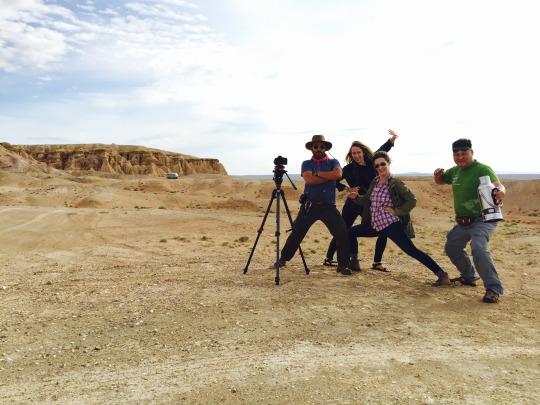
The road trip started off so well… and sober.
Related: How to be a True Nomad: Milking Camels in Mongolia
My crew and I called on this Nomad Code outside of the Singing Sand Dunes in the Southern part of the country, with a friendly ger (yurt) family headed by Ankhaa. We were quickly joined by his curious neighbors. But Timur had neglected to tell us about Mongolian hospitality — or, as Americans might call it, hazing.
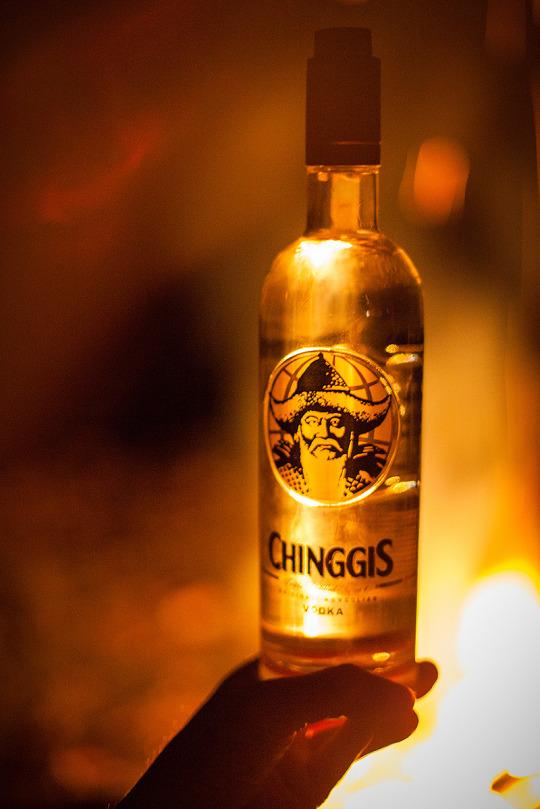
The local poison sold at every kwickie mart in the country. Photo credit: Richard Hirst/Flickr.
After eating camel milk curd, drinking camel milk tea, and then milking said camels to replenish the liquids we had downed, my crew and I were about to go on our way when we remembered the bottles of vodka we had bought for presents to give out to helpful families during our road trip. Our host Ankhaa and his neighbors definitely qualified, so we whipped out a bottle of Chingghis Khan vodka for the families.
What we didn’t realize is that if you present a bottle, you are also expected to drink it with the host. We also were unaware that Mongolian “shots” are soup bowls, and you are expected to down it in one go … and that you cannot have just one.
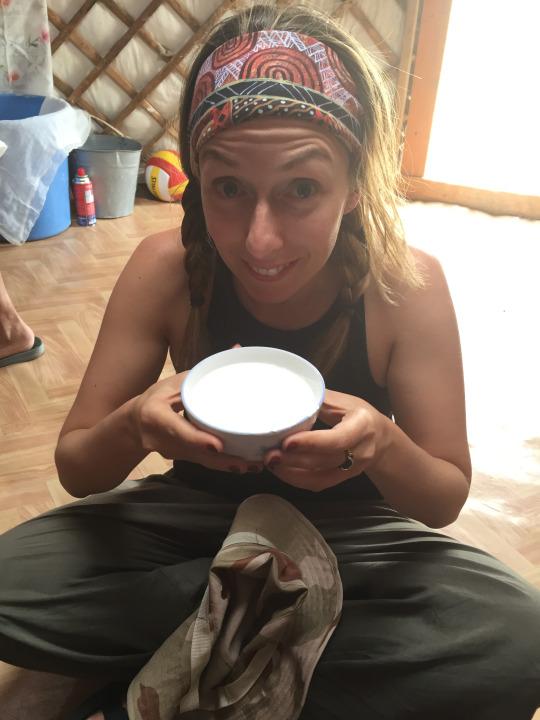
My producer Nicola with her fifth bowl of vodka. Togtoy!
How to Milk A Camel in 5 Easy Steps
Because you just never know when you’re going to need this knowledge. Trust.
For all the awesomeness, subscribe to my YouTube channel, HERE!
WATCH: The Hunt for the Louisiana Swamp Monsters
According to Cajun legend, deep in the Louisiana Swamp is the Rougarou — a large, werewolf-like half-man, half-beast creature who preys on people who venture too far into its terrain.

Photo (modified) by Angie Garrett/Flickr. Design by Lauren DeLuca for Yahoo Travel.
Regarding this legendary beast, History.com says, “The Cajun legend of the Rougarou can take on multiple forms. Originally derived from French stories of the ‘loup-garu,’ or ‘wolf man,’ the monster is most commonly described as a bayou-dwelling werewolf with glowing red eyes and razor-sharp teeth. The beast is usually said to be a cursed man who must shed another’s blood in order to break its spell and reassume human form, but the tale varies according to the teller. In some versions, the Rougarou can turn its victims just by locking eyes with them; in others, it takes the form of a dog or pig rather than a wolf. Still others paint it as a shape shifter that can assume different human and animal forms at will. Because it can switch its appearance so easily, some even conflate the creature with the legendary Skunk Ape of southeastern U.S. swamp lore. In most Louisiana parishes, the Rougarou myth is employed as a kind of cautionary tale. Children are told that the fiend will come for them if they don’t behave, and Catholics are warned that it hunts down those who break Lent.”
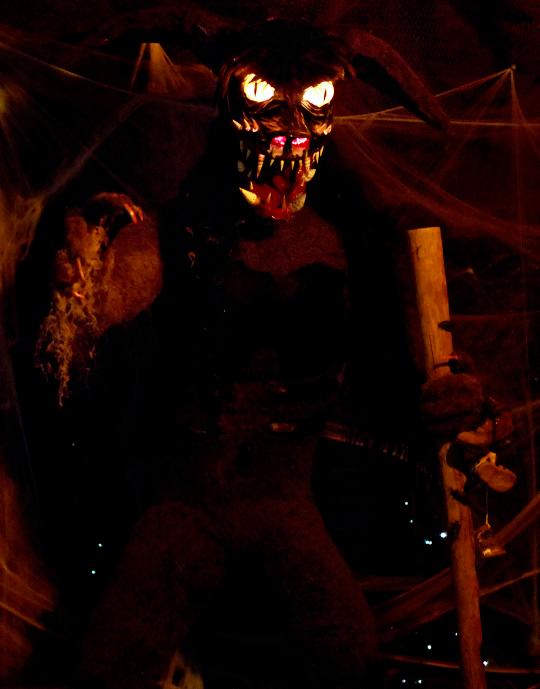
A rougarou on display at the Audubon Zoo in New Orleans. (Photo: praline3001/Flickr)
Since I was in that neck of the woods, I decided to try and see it for myself and check out another supposedly tall tale — the ginormous DinoGator, an alligator that measures up to 50 feet long. Think Lake Placid on steroids.
Related: Inside the Cage of Death With Australia’s Monster Crocs
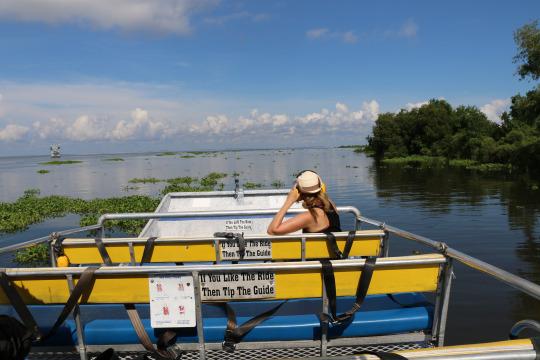
Ready for my monsters.
Raging Out in Sidney Which Got Wild And Weird for Vivid (not the Porn Company)
For two and a half weeks in late spring every year, Sydney takes over the mantle of City of Light (sorry, Paris). The city-wide Vivid Light festival transforms Sydney “into a wonderland of ‘light art’ sculptures, innovative light installations, and grand-scale projections for all to enjoy — for free,” promises the website. “It is a magical celebration of light-design excellence and the world’s largest outdoor ‘art-gallery’: a unique Vivid Sydney experience.”
And it is wild. The facades of public buildings appear to come alive — taken over by (video) vines and (projections of) the ocean. Forests of fluorescent trees sprout up by the waterfront and musical steps that rival that famous scene in the movie Big are everywhere.
It is magical, transformative, and fun. If you’ve ever wanted to go to Australia, book your ticket for the end of May so you can check out Vivid. It is worth every free penny.
How to Swim With Crocodiles
Because, boys and girls, this could actually come in handy. I swear. for full croc awesomeness:
Inside the Cage of Death: Swimming With Australia’s Monster Crocs
Ever since I was a child, I’ve had both an obsessive fascination and fear of saltwater crocodiles. They are one of the only creatures alive today that have been around since the prehistoric time of the dinosaurs — in fact, they are considered by some to be living dinosaurs. Since coming back from the brink of extinction in the mid-20th century, anyone venturing into the Australia’s northern territory can see one … just look on the river banks — or the beaches (crocodiles have been known to surf the waves around Darwin, not kidding). But considering they are expert stealth predator, and several people die every year from croc attacks, how close can you get? Pretty close, it turns out.
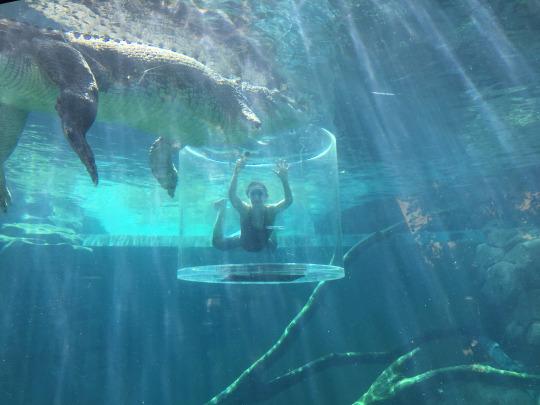
Yes, you can get this close. And yes, it is terrifying.
But before I hit something called the Cage of Death, I’m going to ease into it. Outside of Darwin, on the banks of the Adelaide River, are the Jumping Croc Cruises, where for $30 dollars you can hop on a flat-bottomed boat with roughly 20 other tourists (no dogs allowed, for obvious reasons) and cruise down the muddy river looking for crocodiles, preferably at feeding times (late morning or evening).
Related: Everything in Australia Wants to Kill You
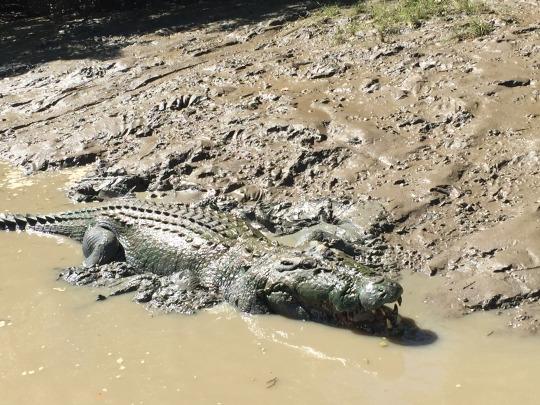
This guy was about 20 feet long … and very hungry.
Boat staff on the boat lure crocs from the riverbanks by attaching red meat to fishing lines and tapping the water with it.
“They feel the vibration in the water and come,” said our baiter, Kyla. “We like to make them jump so they work for their food and burn some calories. The exertion it takes for them to jump cancels out the calories from the meat, so they do still have to hunt in the wild.”
Related: G’Day Mate! How to Speak Australian
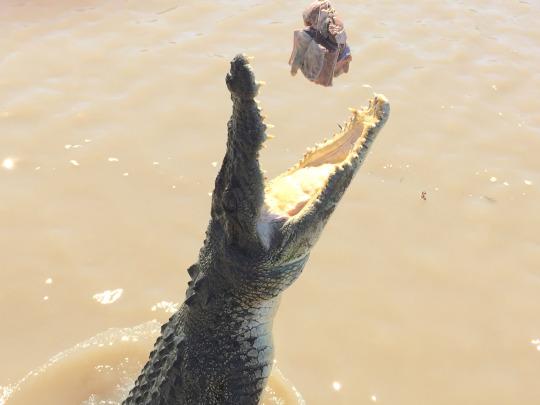
Crocs on the cruise jump as high as five feet for meat — and have been known to jump even higher.
Everything in Australia Wants to Kill You
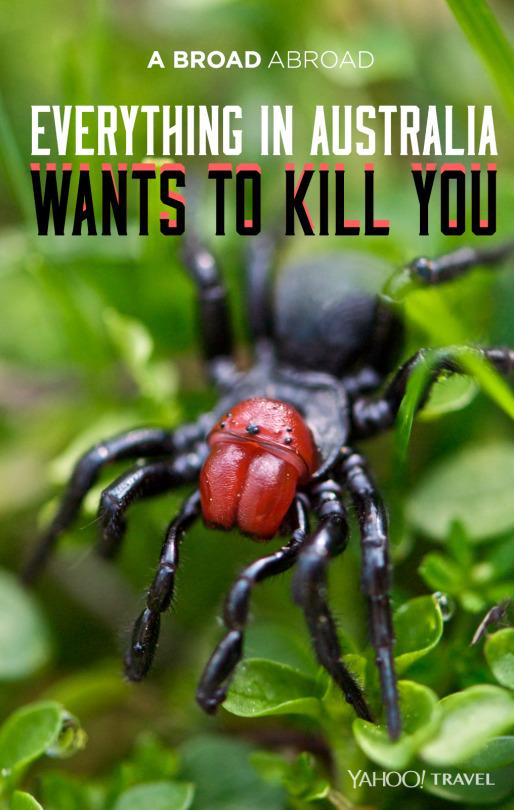
Photo by 167/Brooke Whatnall/Ocean/Corbis. Design by Erik Mace for Yahoo Travel.
It’s a weird, fun fact that as beautiful as it is, everything in Australia wants to kill you. Or at least hurt you real bad. Take, for example, spinifex, the tall grass that grows throughout the desert plains. From far away it looks soft and supple – swaying in the wind.
But this is no Andrew Wyeth bed of grass: spinifex has spikes, thorns, and when it’s dried out it is so strong it can pierce most flip-flops. At least you will (presumably) survive spinifex barbs in your foot. Which is more than I can say for pretty much everything else in Australia.
Related: Experience Uluru, Australia’s Most Awe Inspiring Natural Wonder (Without the 24 Hr flight)

Paula, risking it all in Australia. (Photo: A Broad Abroad)
There are too many to list. Camels in heat will bite your head off? YES THEY WILL! Kangaroos may try to eviscerate you with one back claw judo swipe? HECK, YES THEY WILL! That cute fluffy looking bird will try to peck your eyes out? YOU BET IT WILL!
So I decided to keep it simple and compiled the top 10 things that will kill you — just in case you happen to head to the land down under and need to know the worst things to look out for.
But you may want to travel in a bubble suit, just in case.
Related: G’Day, Mate! How to Speak Australian
How To Feed Your Crocodile
Because you just never know when this info will come in handy… for full croc awesomeness:
G’Day Mate! How to Speak Australian
Australia is an English-speaking country — but, like with England, there are a lot of differences between here and there. So many, in fact, that if you hang with the locals at a pub in the outback, you won’t be totally off base if you sit for a second and wonder, “Just where the hell am I, anyway?”
Related: Lost in Translation: Whose Language Is It Anyway?
Because quite often, Australian English actually needs a translation.
For example, where you might say, “Sharon’s been working very hard, so when we gave her her birthday present she started crying. She needs to toughen up a bit.” — an Australian would translate that to: “Shazza’s been flat out like a lizard drinking. When we gave her a bidet prezzie, the sheila started crying. She needs to drink a cuppa cement.”
Confused? Don’t worry. I’m here to help so that when you take your big trip down under, you’ll fit right in! Watch the video and then, just for fun, translate your thoughts into Australian in the comments below.
